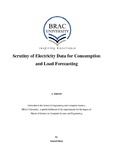Scrutiny of electricity data for consumption and load forecasting
Abstract
In this research, electricity data of Dhaka city, the capital city of Bangladesh has been analysed to use the insights for social good and betterment of electricity sectors. Bangladesh has a very complex electricity infrastructure for both generation and supply sector. According to Power system master plan, Bangladesh mainly produces electricity from gas mine and supply to the grid line. From the gridline, electricity supplies to households. Under the jurisdiction of the Ministry of Power, Energy and Mineral Resources (MPEMR), the Power Division (PD) oversees the whole electricity utility. There are two parts in Dhaka in the historical evolution: old Dhaka and new Dhaka. The responsible department for supplying electricity in these areas are DESCO and DPDC. DESCO is mostly responsible for new Dhaka and extended urban area of Dhaka. The data we have collected from DESCO consist of billing (monthly consumption) data, supply (hourly load) data and load shedding data. Monthly consumption data spans from 1995 to till date, hourly load data and load shedding data span from 2015 to 2016. The objectives of this research can be classified into two parts: one is to analyse monthly consumption/billing data and propose a consumption forecasting model which will predict the consumption in user level. Second, analyzing load/supply data (along with load-shedding data) to understand how legacy method works, addressing key points to ensure a better forecasting, how forecasting will help in future, a brief study of recent forecasting techniques, load shedding scenario, area specific impacts and proposing a forecasting technique which ensures granularity and relatively higher accuracy. It has been found that electricity consumption varies a lot for different tariff bracket consumers in a zone. Consumers from same tariff bracket act differently in different zones. Moreover, electricity usage is strongly correlated with temperature, seasonal change and an occasional change. If temperature increases, electricity usage also increases, usage changes a lot due to particular events. So, forecasting the demand (consumer and substation level) is a crucial part. A proper flow of information is a must from consumer level to the generation plants to predict future demand with minimal error

